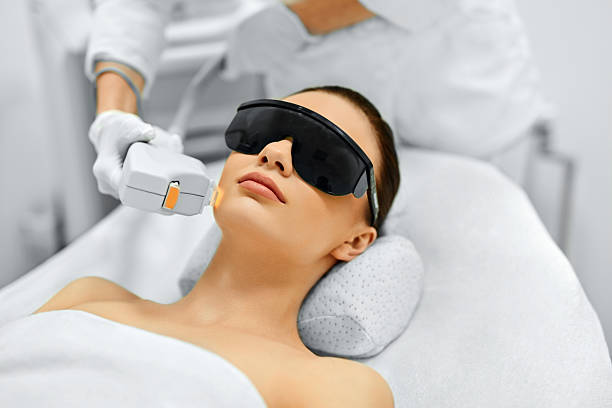The treatment for skin that has been photoaged can be classified into two categories. Type I is the one that involves treating irregularly pigmented skin, vessels, pilosebaceous changes. Type II involves the enhancement of dermal and subcutaneous skin senescence. 1
The process of rejuvenating the skin is one which aims to restore the appearance of youth. The past was when it was a process that involved the use of invasive procedures like facelifts. The demand for rejuvenation treatments and non-invasive procedures has increased dramatically in the last 10 years, leading to many advancements in this field. There is a huge demand for procedures that can provide faster healing and more natural-looking skin with less downtime and negative consequences, and an option for treating a greater spectrum kinds of facial skin. One of these treatments involves using lasers and other sources of light. Lasers (an acronym for light amplification through stimulating emission) became popular to treat skin aging in the 1980s after an understanding of the process known as specific photo thermolysis. 2 Laser devices to treat type I pigment or vascular irregularities comprise lasers that emit light with the wavelengths 532/585 595 755 and 800, as well as 1,064 nm as well being filtered light produced from intense pulsed lighting (IPL) techniques. Lasers that emit light at frequencies of 1320, 1,540, and 1,540 nm that target water, as well as Pulsed dye lasers (PDL), which specifically target oxyhemoglobin, are utilized to treat type II rejuvenation. 3
In 2017, dermatologists performed more than 8 million cosmetic procedures in the United States, a 19 percent increase over the year 2016. There was a significant increase in the amount of skin resurfacing procedures that use lasers and light-based techniques (3.27 million). 4 This shows the desire of people to look and feel appealing and youthful. The method that utilizes lasers and light sources to improve the appearance of skin is the removal of old skin tissues, and thereby causing the destruction of tissues through thermal heat produced by lasers with high power. The surrounding tissues heal by the natural healing process. The different types of lasers that are involved are ablative lasers, nonablative lasers, as well as fractional ablative lasers. The introduction of the technique known as photobiomodulation (PBM), which uses low-energy LEDs, or lasers (LEDs), has demonstrated positive results in the reduction of wrinkles as well as the improvement in skin relaxation. There are some limitations to the treatments and methods as well as the potential risk and outcomes, especially when using high-powered lasers, must be taken into consideration.
Laser skin Resurfacing and chemical peels can both diminish wrinkles and rough skin. However, chemical peels aren’t able to do as well for deep wrinkles or sagging skin, and lasers also have the benefit of continuous improvement over time because of the increased collagen production. Chemical peels function in the same manner as laser resurfacing by creating immunohistologic signs that resemble wound healing. They are classified according to the degree of damage. 5 Superficial peels are suggested as a treatment for the treatment of photoaging (superficial wrinkles) and pigmentary conditions (superficial) and acne. They remove the epidermis but do not destroy the skin’s basal layer.
Medium peels are suggested to treat wrinkles and lines and the pigmentary disorder (contraindicated for Melasma) and superficial atrophic scars. They are able to penetrate the epidermis and then an epidermis that is papillary. 5 Deep peels penetrate the dermis midreticular and are recommended for treating serious photoaging, pigmentary disorders, and marks. [5], [6]
Hyperpigmentation or deep wrinkles aren’t able to be corrected by chemical peels, and more than men’s skin because of its thickness 7 and the possibility of heart failure, which could be a consequence of deep chemical peels limiting their clinical efficacy and value. This is why laser resurfacing is typically preferable to chemical peels. 6
Section Snippets
Tissue optics
Skin’s physical characteristics, such as the skin such as chemical, optical, and mechanical properties, as well as the concentration and distribution of the constituents that compose the tissue, influence the way laser light interacts with the tissue. When light from the incident source gets into contact with the skin, there are four outcomes possible:
- Reflection: photons bounce off skin, and there isn’t any light-tissue interaction. This is about 3 percent of the visible light. 8
- Scattering Shorter wavelengths scatter more, while the longer wavelengths scatter less.
Laser-tissue interaction
When light from lasers interacts with the tissue of the body, Three reactions can occur:
- Photochemical: The absorbed light particles from low-powered irradiation can interact with cells on a molecular level and trigger a chemical reaction inside the cells. It can activate or deactivate certain cell-specific pathways and processes. In photochemical reactions, there is no change in temperature local to. A slight increase in temperature, between 45degC and 50degC, causes hyperthermia, a reduction in enzyme activity
Photothermolysis
To fully comprehend how lasers can be efficient in rejuvenating skin and how they work, it is necessary to comprehend the fundamentals of photothermolysis. Photothermolysis is a method used to target tissue within an area that isn’t damaging the tissue surrounding it. This is possible due to the fact that various wavelengths possess different levels of penetration into tissues (longer wavelengths have greater perforation into tissue) and are absorbent by various chromophores (a chemical group that absorbs light in the wavelength of a
Lasers are used to rejuvenate skin
Lasers commonly employed for treatments for skin rejuvenation comprise nonablative, ablative, or fractional (Figure 2.). Lasers that remove the epidermis and heat the dermis. They are usually utilized to resurface and renew the skin. They are also utilized to treat rhytides hyperpigmentation, scars, and dyspigmentation. 10 Nonablative lasers do not harm the epidermis by cooling, yet allow the heating and denature of dermal proteins like collagen, which increases collagen production and improves the appearance of skin.




